Abstract
The term enteroviruses was introduced in 1957 to bring together in one large family the polioviruses, Coxsackie A and B and echoviruses, all agents for which the human alimentary tract is the natural habitat. At present more than 60 distinct members are recognized: three polioviruses, 24 Coxsackie A, six Coxsackie B and 30 echoviruses. The list of new members, particularly in the echo-group, grows regularly. The viruses are frequently widely disseminated in the summer and fall of the year, circulating chiefly among young children, causing both apparent and inapparent infection. The enteroviruses are responsible for a wide spectrum of clinical manifestations, including non-specific febrile illness, sometimes with rash, aseptic meningitis, paralytic disease, respiratory infections, pericarditis and myocarditis. There is considerable overlap in biologic behavior, and the same syndrome can be induced by many different agents.
In a few instances the clinical pattern is distinct enough to suggest the group of agents involved. Thus, herpangina is associated with the Coxsackie A viruses and epidemic myalgia (devil's grip) with the Coxsackie B group. Paralytic disease is caused primarily by the polioviruses, but recently it has been found that other members, particularly the Coxsackie B viruses and Coxsackie A7 can also cause “paralytic poliomyelitis.”
The ultimate potential of enteroviruses in terms of central nervous system disease and other manifestations is unpredictable. Great variety in terms of clinical and epidemiologic behavior of known and “new” viruses has been the pattern in the past, and is likely to continue.
Full text
PDF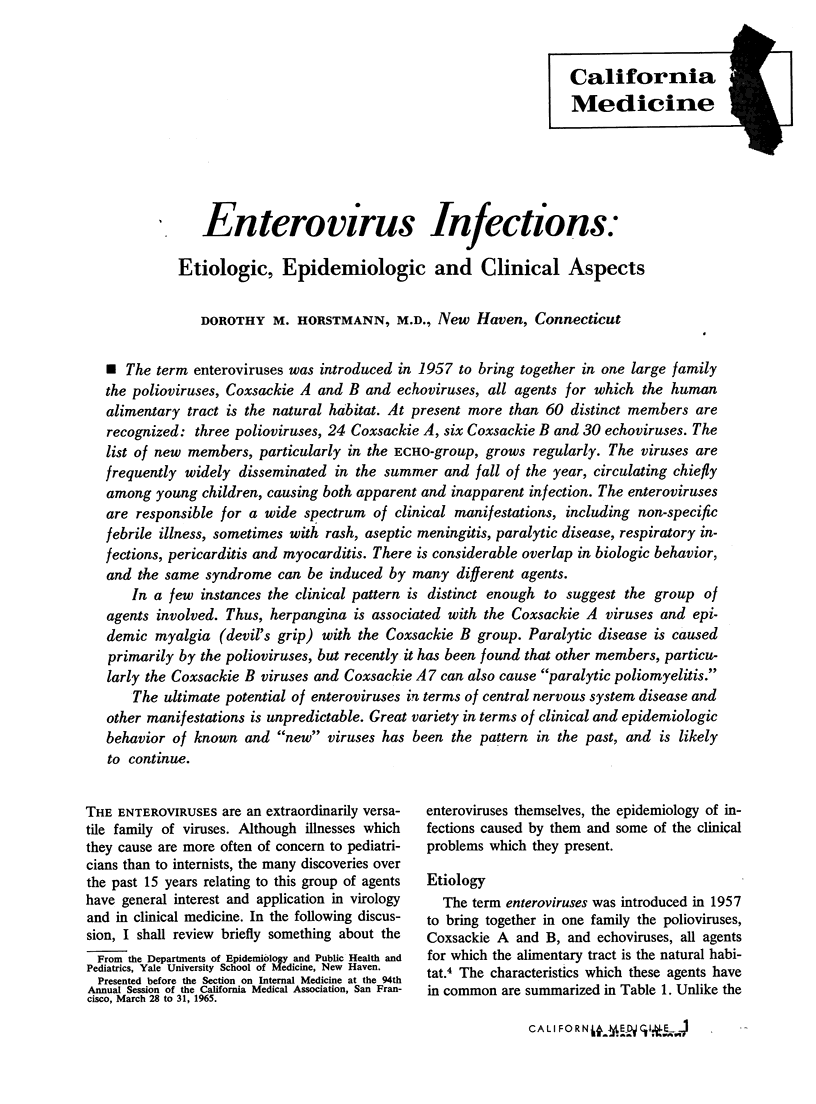
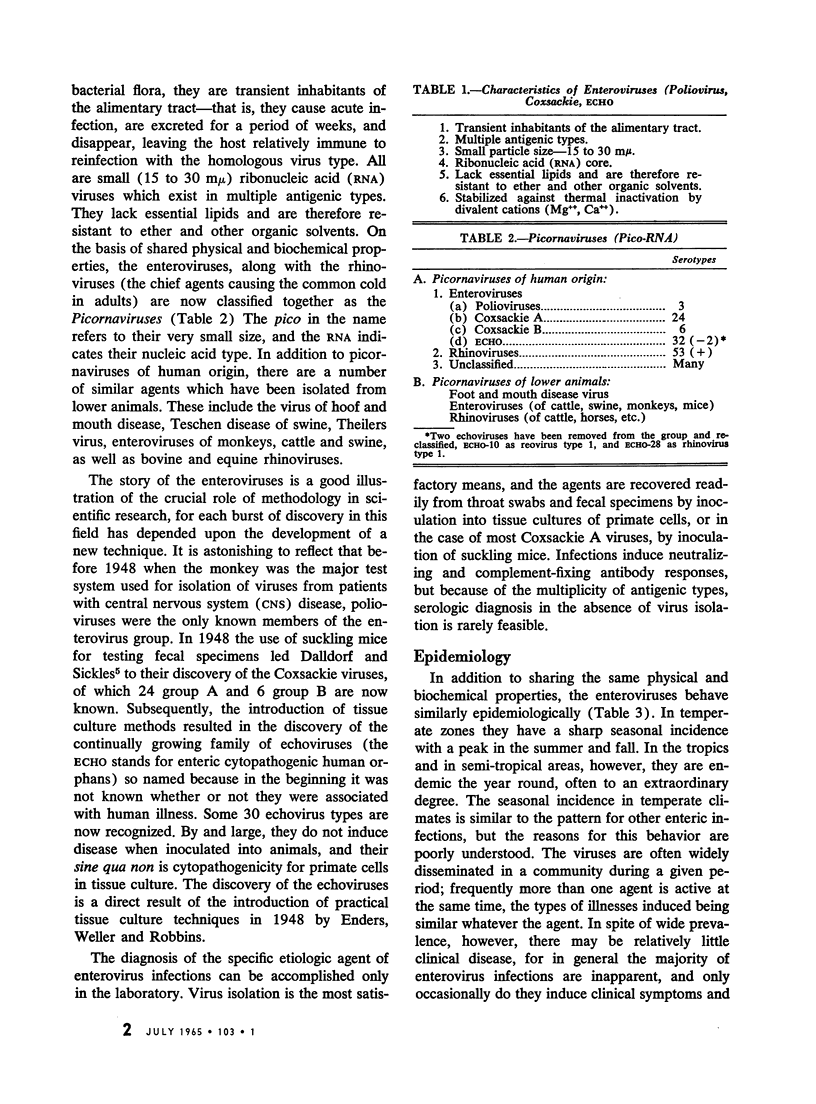
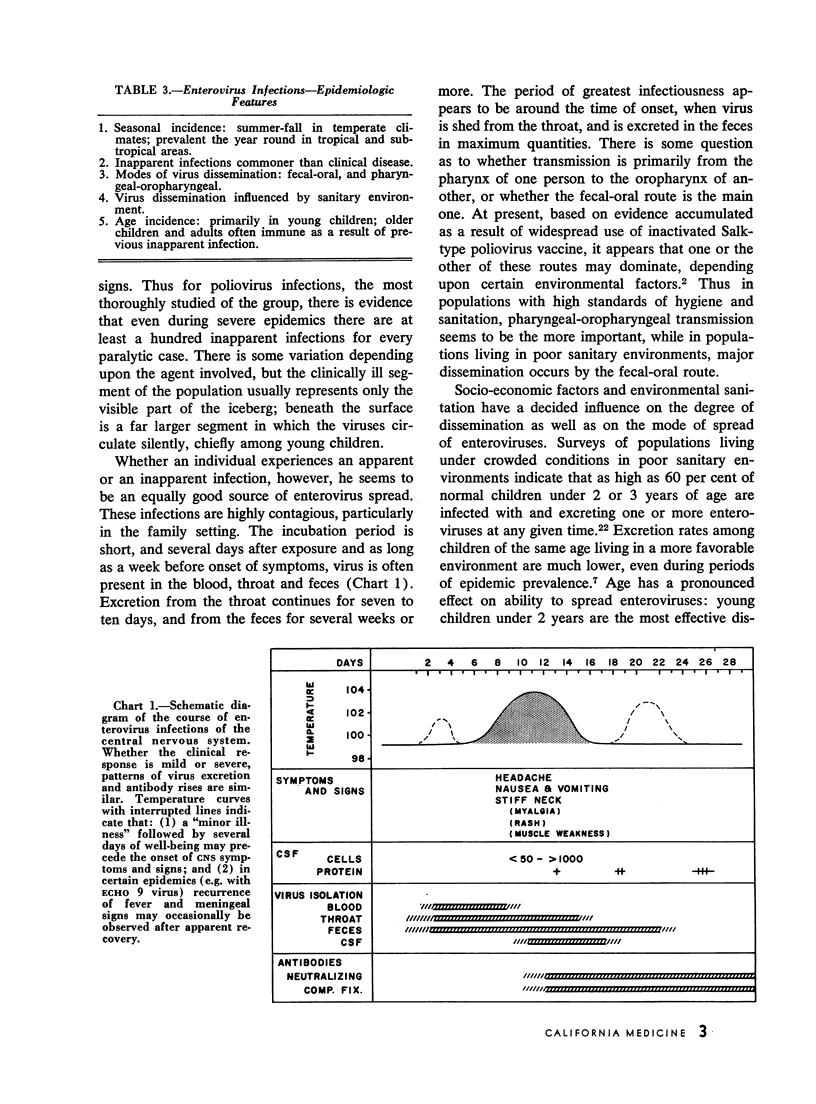
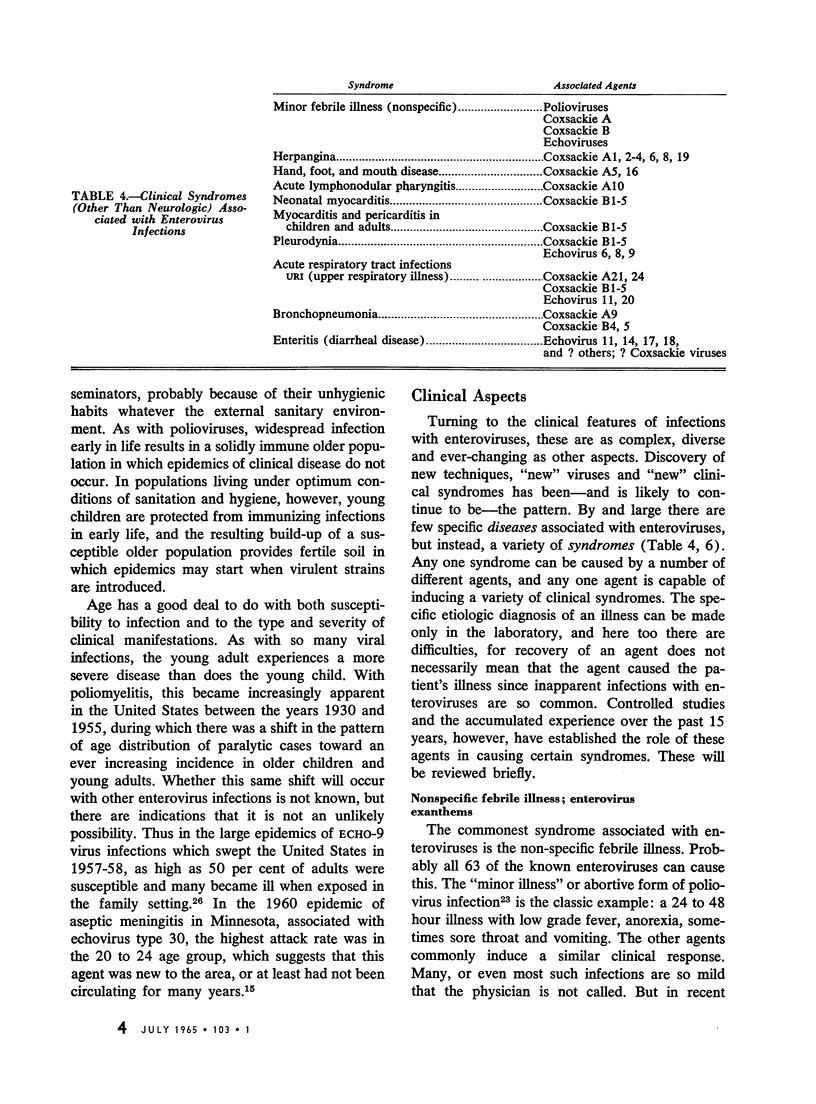

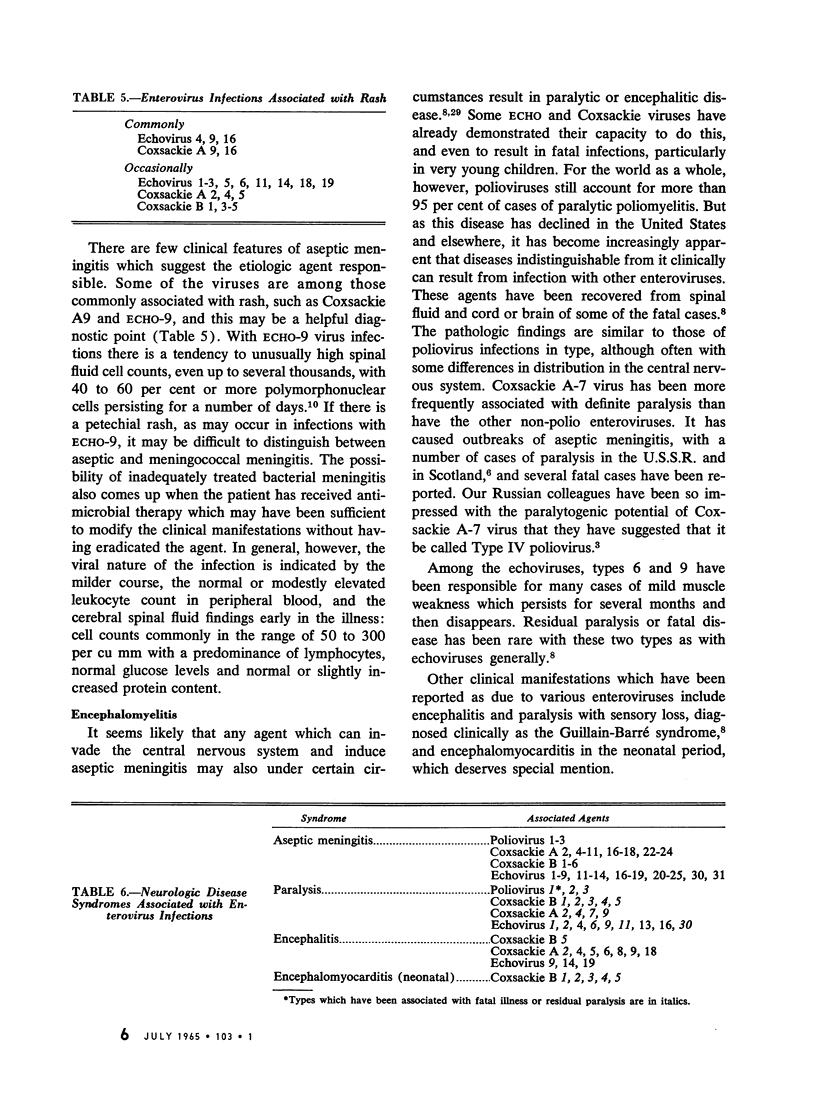
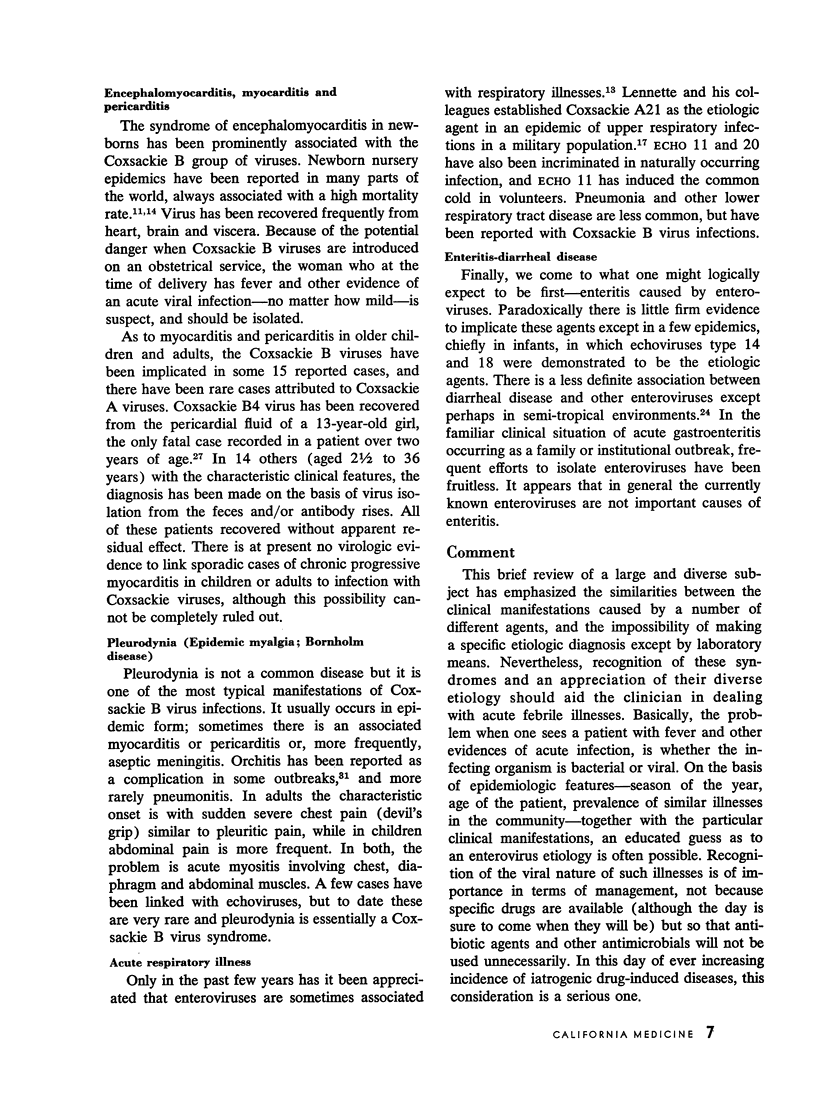
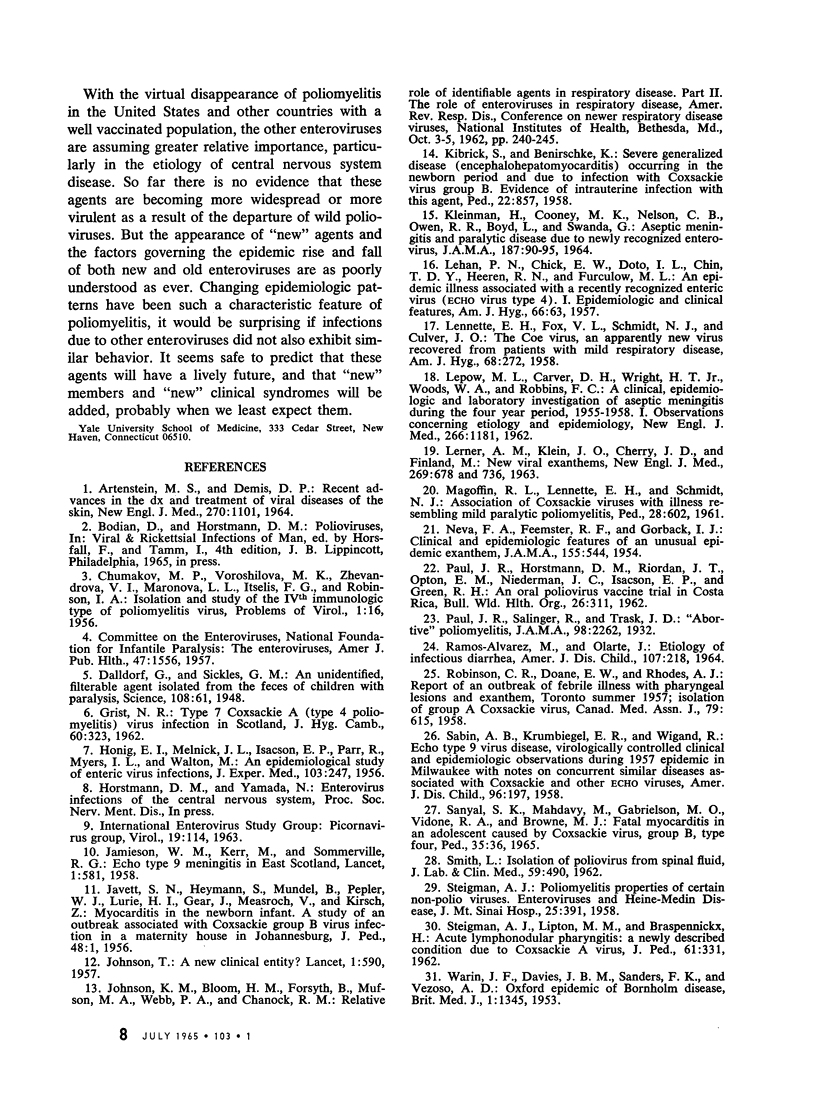
Selected References
These references are in PubMed. This may not be the complete list of references from this article.
- ARTENSTEIN M. S., DEMIS D. J. RECENT ADVANCES IN THE DIAGNOSIS AND TREATMENT OF VIRAL DISEASES OF THE SKIN. N Engl J Med. 1964 May 21;270:1101–1111. doi: 10.1056/NEJM196405212702107. [DOI] [PubMed] [Google Scholar]
- GRIST N. R. Type A7 Coxsackie (type 4 poliomyelitis) virus infection in Scotland. J Hyg (Lond) 1962 Sep;60:323–332. doi: 10.1017/s002217240002043x. [DOI] [PMC free article] [PubMed] [Google Scholar]
- HONIG E. I., MELNICK J. L., ISACSON P., PARR R., MYERS I. L., WALTON M. An endemiological study of enteric virus infections: poliomyelitis, coxsackie, and orphan (ECHO) viruses isolated from normal children in two socioeconomic groups. J Exp Med. 1956 Feb 1;103(2):247–262. doi: 10.1084/jem.103.2.247. [DOI] [PMC free article] [PubMed] [Google Scholar]
- JAMIESON W. M., KERR M., SOMMERVILLE R. G. ECHO type-9 meningitis in East Scotland. Lancet. 1958 Mar 15;1(7020):581–583. doi: 10.1016/s0140-6736(58)91211-x. [DOI] [PubMed] [Google Scholar]
- JAVETT S. N., HEYMANN S., MUNDEL B., PEPLER W. J., LURIE H. I., GEAR J., MEASROCH V., KIRSCH Z. Myocarditis in the new newborn infant; a study of an outbreak associated with Coxsackie group B virus infection in a maternity home in Johannesburg. J Pediatr. 1956 Jan;48(1):1–22. doi: 10.1016/s0022-3476(56)80111-x. [DOI] [PubMed] [Google Scholar]
- KIBRICK S., BENIRSCHKE K. Severe generalized disease (encephalohepatomyocarditis) occurring in the newborn period and due to infection with Coxsackie virus, group B; evidence of intrauterine infection with this agent. Pediatrics. 1958 Nov;22(5):857–875. [PubMed] [Google Scholar]
- KLEINMAN H., COONEY M. K., NELSON C. B., OWEN R. R., BOYD L., SWANDA G. ASEPTIC MENINGITIS AND PARALYTIC DISEASE DUE TO NEWLY RECOGNIZED ENTEROVIRUS. JAMA. 1964 Jan 11;187:90–95. doi: 10.1001/jama.1964.03060150014004. [DOI] [PubMed] [Google Scholar]
- LEHAN P. H., CHICK E. W., DOTO I. L., CHIN T. D., HEEREN R. H., FURCOLOW M. L. An epidemic illness associated with a recently recognized enteric virus (ECHO virus type 4). I. Epidemiologic and clinical features. Am J Hyg. 1957 Jul;66(1):63–75. doi: 10.1093/oxfordjournals.aje.a119886. [DOI] [PubMed] [Google Scholar]
- LENNETTE E. H., FOX V. L., SCHMIDT N. J., CULVER J. O. The Coe virus: an apparently new virus recovered from patients with mild respiratory disease. Am J Hyg. 1958 Nov;68(3):272–287. [PubMed] [Google Scholar]
- LEPOW M. L., CARVER D. H., WRIGHT H. T., Jr, WOODS W. A., ROBBINS F. C. A clinical, epidemiologic and laboratory investigation of aseptic meningitis during the four-year period, 1955-1958. I. Observations concerning etiology and epidemiology. N Engl J Med. 1962 Jun 7;266:1181–1187. doi: 10.1056/NEJM196206072662301. [DOI] [PubMed] [Google Scholar]
- LERNER A. M., KLEIN J. O., CHERRY J. D., FINLAND M. NEW VIRAL EXANTHEMS (CONCLUDED). N Engl J Med. 1963 Oct 3;269:736–CONCL. doi: 10.1056/NEJM196310032691406. [DOI] [PubMed] [Google Scholar]
- LERNER A. M., KLEIN J. O., CHERRY J. D., FINLAND M. NEW VIRAL EXANTHEMS. N Engl J Med. 1963 Sep 26;269:678–685. doi: 10.1056/NEJM196309262691307. [DOI] [PubMed] [Google Scholar]
- MAGOFFIN R. L., LENNETTE E. H., SCHMIDT N. J. Association of Coxsackie viruses with illnesses resembling mild paralytic polimyelitis. Pediatrics. 1961 Oct;28:602–613. [PubMed] [Google Scholar]
- RAMOS-ALVAREZ M., OLARTE J. DIARRHEAL DISEASES OF CHILDREN. THE OCCURRENCE OF ENTEROPATHOGENIC VIRUSES AND BACTERIA. Am J Dis Child. 1964 Mar;107:218–231. doi: 10.1001/archpedi.1964.02080060220002. [DOI] [PubMed] [Google Scholar]
- ROBINSON C. R., DOANE F. W., RHODES A. J. Report of an outbreak of febrile illness with pharyngeal lesions and exanthem: Toronto, summer 1957; isolation of group A Coxsackie virus. Can Med Assoc J. 1958 Oct 15;79(8):615–621. [PMC free article] [PubMed] [Google Scholar]
- STEIGMAN A. J., LIPTON M. M., BRASPENNICKX H. Acute lymphonodular pharyngitis: a newly described condition due to Coxsackie A virus. J Pediatr. 1962 Sep;61:331–336. doi: 10.1016/s0022-3476(62)80365-5. [DOI] [PubMed] [Google Scholar]
- STEIGMAN A. J. Poliomyelitic properties of certain non-polio viruses: enteroviruses and heine-Medin disease. J Mt Sinai Hosp N Y. 1958 Sep-Oct;25(5):391–404. [PubMed] [Google Scholar]
- WARIN J. F., DAVIES J. B. M., SANDERS F. K., VIZOSO A. D. Oxford epidemic of Bornholm disease, 1951. Br Med J. 1953 Jun 20;1(4824):1345–1351. doi: 10.1136/bmj.1.4824.1345. [DOI] [PMC free article] [PubMed] [Google Scholar]


